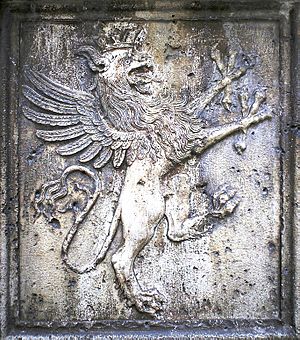Griffin facts for kids
The griffin or gryphon is a famous legendary creature from old stories and myths. It's a mix of two powerful animals: it has the body, tail, and back legs of a lion, but the head and wings of an eagle. Sometimes, its front feet are also like an eagle's talons.
People in the past saw the griffin as a symbol of great strength and skill. It was often believed to guard valuable treasure. Today, the griffin is still used as a symbol. For example, Brisbane Waters Secondary College in Australia uses the griffin as its symbol, with the motto "Strength Through Unity."
| Grouping | Mythological hybrids |
|---|---|
| Similar creatures | Hippogriff, simurgh, Poubi Lai, Uchek Langmeidong, Pakhangba, Keibu Keioiba, sphinx |
| Mythology | Ancient Egyptian, Persian, Renaissance |
| Other name(s) | Griffon, gryphon |
Contents
The Griffin's Ancient History
Griffins have appeared in art for thousands of years. We can find pictures of them in Ancient Iranian and Ancient Egyptian art from before 3000 BC.
Early Griffin Sightings
In Egypt, one of the oldest griffin pictures is on a special stone palette. This "Two Dog Palette" is from around 3300-3100 BC. In Iran, griffins were carved on cylinder seals as early as 3000 BC.
Later, griffins started appearing in the Middle Bronze Age (around 1950-1550 BC). You can see them in places like the Levant, Syria, and Anatolia.
Griffins in Ancient Greece
The ancient Greeks also loved griffins. Some of the earliest Greek griffin pictures are from the 15th century BC. They are found in the frescoes of the Throne Room at the Palace of Knossos. This palace was on the island of Crete. Griffins remained a popular design in Greek art for many centuries.

Griffins in Central Asia
About a thousand years after the Bronze Age, griffins appeared in Central Asia. This was around the 5th–4th centuries BC. They likely came from the Achaemenid Empire in Persia. The Achaemenids believed griffins could protect them from evil, magic, and secret gossip.
Historians like Robin Lane Fox have noted griffins in art from this time. For example, a mosaic in Pella shows a griffin attacking a deer. This might have been a symbol for the kingdom of Macedon.
The Pisa Griffin
One very famous griffin sculpture is the Pisa Griffin. It's a large bronze statue that has been in Pisa, Italy, since the Middle Ages. However, it was actually made in the Islamic world. It is the biggest known medieval Islamic bronze sculpture, standing over a meter tall (1.08 m). It was probably created in the 11th century in Al-Andalus (Islamic Spain).
Around 1100, the Pisa Griffin was placed on a column on the roof of Pisa Cathedral. In 1832, a copy replaced it. The original griffin is now safely kept in the Cathedral Museum in Pisa.
Images for kids
-
Bronze griffins from ancient Luristan, Iran, 1st millennium BC. Vorderasiatisches Museum Berlin
-
Bronze griffin head from Olympia, Greece. 7th century BC. Olympia museum
-
The Pisa Griffin, in the Pisa Cathedral Museum, 11th century
-
The main coin design of the Greek city of Abdera was called "the Griffon" because of this mythical animal
-
Griffin inscription at Sanchi Stupa from the 3rd century BCE
-
Statue of a griffin at St Mark's Basilica in Venice
-
Illustration for Mandeville's legend by H. J. Ford, 1899
-
Griffin misericord, Ripon Cathedral, thought to inspire the Gryphon in Lewis Carroll’s Alice's Adventures in Wonderland
-
The Gryphon is the emblem and mascot of the University of Guelph
-
Early historic references to the gryphon describe the area of the Dzungarian Gate, where Protoceratops and Psittacosaurus skeletons are common.
-
Rogue taxidermy griffin, Zoological Museum, Copenhagen
See also
 In Spanish: Grifo para niños
In Spanish: Grifo para niños






















